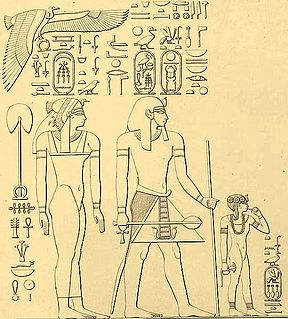
Hatshepsut was the fifth pharaoh of the Eighteenth Dynasty of Egypt. She was the second historically-confirmed female pharaoh, the first being Sobekneferu.
The 1470s BC was a decade lasting from January 1, 1479 BC to December 31, 1470 BC.

Thutmose III was the sixth pharaoh of the Eighteenth Dynasty. Officially, Thutmose III ruled Egypt for almost 54 years and his reign is usually dated from 24 April 1479 BC to 11 March 1425 BC, from the age of two and until his death at age fifty-six; however, during the first 22 years of his reign, he was coregent with his stepmother and aunt, Hatshepsut, who was named the pharaoh. While he was shown first on surviving monuments, both were assigned the usual royal names and insignia and neither is given any obvious seniority over the other. Thutmose served as the head of Hatshepsut's armies. During the final two years of his reign, he appointed his son and successor, Amenhotep II, as his junior co-regent. His firstborn son and heir to the throne, Amenemhat, predeceased Thutmose III.

Ahmose was an Ancient Egyptian queen in the Eighteenth Dynasty. She was the Great Royal Wife of the dynasty's third pharaoh, Thutmose I, and the mother of the queen and pharaoh Hatshepsut. Her name means "Born of the Moon".

Thutmose II was the fourth Pharaoh of the Eighteenth dynasty of Egypt. He built some minor monuments and initiated at least two minor campaigns but did little else during his rule and was probably strongly influenced by his wife, Hatshepsut. His reign is generally dated from 1493 to 1479 BC. Thutmose II's body was found in the Deir el-Bahri Cache above the Mortuary Temple of Hatshepsut and can be viewed today in the Egyptian Museum in Cairo.

Amenhotep I from Ancient Egyptian "jmn-ḥtp" or "yamānuḥātap" meaning "Amun is satisfied" or Amenophis I, (,), from Ancient Greek Ἀμένωφις, additionally King Zeserkere, was the second Pharaoh of the 18th dynasty of Egypt. His reign is generally dated from 1526 to 1506 BC. He was a son of Ahmose I and Ahmose-Nefertari, but had at least two elder brothers, Ahmose-ankh and Ahmose Sapair, and was not expected to inherit the throne. However, sometime in the eight years between Ahmose I's 17th regnal year and his death, his heir apparent died and Amenhotep became crown prince. He then acceded to the throne and ruled for about 21 years. Although his reign is poorly documented, it is possible to piece together a basic history from available evidence. He inherited the kingdom formed by his father's military conquests and maintained dominance over Nubia and the Nile Delta but probably did not attempt to maintain Egyptian power in the Levant. He continued the rebuilding of temples in Upper Egypt and revolutionized mortuary complex design by separating his tomb from his mortuary temple, setting a trend in royal funerary monuments which would persist throughout the New Kingdom. After his death, he was deified as a patron god of Deir el-Medina.

Senenmut was an 18th dynasty ancient Egyptian architect and government official. His name translates literally as "mother's brother."

Deir el-Bahari or Dayr al-Bahri is a complex of mortuary temples and tombs located on the west bank of the Nile, opposite the city of Luxor, Egypt. This is a part of the Theban Necropolis.

Ahmose-Nefertari of Ancient Egypt was the first Queen of the 18th Dynasty. She was a daughter of Seqenenre Tao and Ahhotep I, and royal sister and the great royal wife of pharaoh, Ahmose I. She was the mother of king Amenhotep I and may have served as his regent when he was young. Ahmose-Nefertari was deified after her death.

The Red Chapel of Hatshepsut or the Chapelle Rouge originally was constructed as a barque shrine during the reign of Hatshepsut. She was the fifth pharaoh of the eighteenth dynasty of Ancient Egypt and ruled from approximately 1479 to 1458 BC.

The Theban Necropolis is a necropolis on the west bank of the Nile, opposite Thebes (Luxor) in Upper Egypt. It was used for ritual burials for much of the Pharaonic period, especially during the New Kingdom.

Ahhotep I was an Ancient Egyptian queen who lived circa 1560–1530 BC, during the end of the Seventeenth Dynasty of Egypt. She was the daughter of Queen Tetisheri and Senakhtenre Ahmose, and was probably the sister, as well as the queen consort, of Pharaoh Seqenenre Tao ll. Ahhotep I had a long and influential life. She ruled as regent for her son Ahmose I for a time.

Ahhotep II was an Ancient Egyptian queen, and likely the Great Royal Wife of Pharaoh Kamose.

Mutnofret, also rendered as Mutneferet or Mutnefert, was a queen during the Eighteenth dynasty of Egypt. She was a secondary wife of Thutmose I—Queen Ahmose was the chief wife—and the mother of Thutmose II.
Meritamen was a princess during the Eighteenth dynasty of Egypt. She was the daughter of Pharaoh Thutmose III and his Great Royal Wife Merytre-Hatshepsut. She is also called Meritamun.
Bas-relief carvings in the Ancient Egyptian temple of Deir el-Bahari depict events in the life of the pharaoh or monarch Hatshepsut of the Eighteenth Dynasty. They show the Egyptian gods, in particular Amun, presiding over her creation, and describe the ceremonies of her coronation. Their purpose was to confirm the legitimacy of her status as a woman pharaoh. Later rulers attempted to erase the inscriptions.
The Eighteenth Dynasty of Egypt is classified as the first dynasty of the New Kingdom of Egypt, the era in which ancient Egypt achieved the peak of its power. The Eighteenth Dynasty spanned the period from 1549/1550 to 1292 BC. This dynasty is also known as the Thutmosid Dynasty for the four pharaohs named Thutmose.
The Temple of Thutmose III at Deir el-Bahari was first revealed in February 1962 by excavators of the Polish Centre of Mediterranean Archaeology, under the direction of Kazimierz Michalowski. Poorly preserved, this structure was designated in pharaonic times as (Amun)-Djeser-akhet.

Sewahenre Senebmiu is a poorly attested Egyptian pharaoh of the late 13th dynasty during the Second Intermediate Period. According to egyptologist Jürgen von Beckerath, he was the forty-first king of the 13th dynasty. Alternatively, Darrell Baker proposes that he may have been its fifty-seventh ruler. Kim Ryholt only specifies that Senebmiu's short reign dates to between 1660 BC and 1649 BC.

















